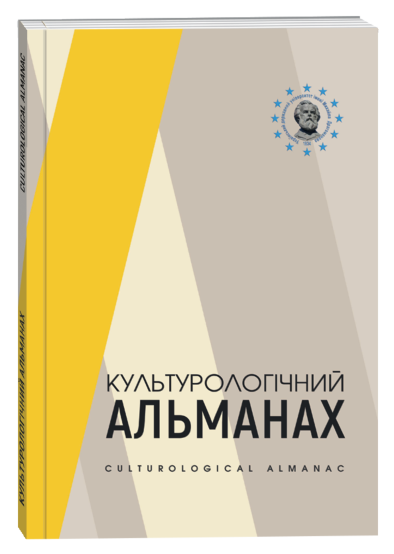THEOLOGY OF CHILDHOOD: METHODOLOGICAL CHALLENGES AND FUNCTIONAL POTENTIAL
DOI:
https://doi.org/10.31392/cult.alm.2025.1.22Keywords:
childhood, child, theology, theology of childhood, child theology, methodological challengesAbstract
This article examines the socio-cultural challenges that shape the development of the theology of childhood.Particular attention is given to the methodological complexities of enhancing children’s activity, collaboration, and participation as subjects and co-researchers in theology.The practice of theology for children with necessitates actualizes the paradigm shift in how children and childhood are perceived within classical systematic theology. The article extends philosophical reflections on the methodological distinctions and semantic clarifications of the concepts of “children’s theologies”, “theology of childhood”, “theology for children” and “child theology”. While these terms may seem interchangeable at first glance, a closer methodological examination reveals clear differences between them. Specifically, the primary objective of the theology of childhood is to foster an understanding of children and childhood, as well as to uphold theological commitments toward children themselves.It is emphasized that theology with children should not be confined to religious education but should instead be regarded as an integral aspect of all theological disciplines, necessitating active listening of children. At the same time, this approach seeks to shift the objectification of young people in theological reflection toward their re-subjectification, enabling them to act as agents of theology, shaping religious discourse alongside educated adults.Modern theological practices with children are increasingly being developed according to the principles of the hermeneutic circle. The article provides examples of the implementation of inclusive methodologies for engaging children in theological discussions. One of the key aspects of the functional potential of theology with children is identified as the bridging of the epistemological gap between adults and children
References
Asbridge, N., (2009). ‘What is a child?’, in A. Richards & P. Privett (eds.), Through the eyes of a child. New insights in theology from a child’s perspective, pp. 1–20, Church House, London.
Berryman, J.W., (2009). Children and the theologians. Clearing the way for grace, Morehouse, New York, NY.
Berryman, J.W., (2013). ‘Theologizing with children – A parable approach’, in B. Hyde (ed.), The search for a theology of childhood – Essays by Jerome W Berryman from 1978–2009, Loc. 4250–4629, Modotti Press, Ballarat, Kindle edn.
Betsworth, S. & Parker, J.F. (eds.), (2019). T & T Clark handbook of children in the Bible and the Biblical World, T & T Clark, London.
Betsworth, S., (2019) ‘Jesus (and) the only child: Jesus, children and the Gospel of Luke’, in J.P. Grimshaw (ed.), Luke-Acts, pp. 9–22, Texts@Contexts, T & T Clark, London.
Briggs, M.R., (2017). How children read Biblical narrative: An investigation of children’s readings of the Gospel of Luke, Pickwick, Eugene, OR, Kindle edn.
Bunge, M.J., (ed.), (2001). The child in Christian thought, William B. Eerdmans Publishing, Grand Rapids,
Bunge, M.J., (2004). ‘Historical perspectives on children in the church: Resources for spiritual formation and a theology of childhood today’, in D. Ratcliff (ed.), Children’s spirituality. Christian perspectives, research and applications, pp. 42–53, Cascade Books, Eugene, OR.
Bunge, M.J., (2006). ‘The child, religion and the academy. Developing robust theological and religious understandings of children and childhood’, Journal of Religion 86(4), 549–579. https://doi.org/10.1086/505894
Bunge, M.J., (2008). ‘Introduction’, in M.J. Bunge, T.E. Fretheim & B.R. Gaventa (eds.), The child in the Bible, pp. xiv–xxvi, William B. Eerdmans, Grand Rapids, MI.
Bunge, M.J., (2011). ‘Biblical understandings of children and childhood: Resources for the church and mission today’, in K.J. White (ed.), Now and next, a compendium of papers presented at the Now & Next theological conference on children, Nairobi, Kenya, 9–12th March, pp. 15–35, Compassion International, Colorado Springs, CO
Bunge, M.J., (2012). ‘Biblical and theological perspectives and best practices for faith formation’, in K.E. Lawson (ed.), Understanding children’s spirituality. Theology, research, and practice, pp. 4–25, Cascade Books, Eugene, OR, Kindle edn.
Bunge, M.J., (2016). ‘Task, sources and significance of theologies of childhood, in J. Grobbelaar & G. Breed (eds.), Theologies of childhood and the children of Africa, pp. 92–112, AOSIS, Cape Town.
Coles, R., (1990). The spiritual life of children, Houghton Mifflin, Boston, MA.
Cooey, P.M., (2010). ‘Neither seen nor heard: The absent child in the study of religion’, Journal of Childhood and Religion 1(1), 1–31.
Dean, K.C., (2010). ‘Fessing up: Owing our theological commitments’, in K.C. Dean, C. Clark & D. Rahn, (eds.) Starting right: Thinking theologically about youth ministry, pp. 28–40, Youth Specialities, Zondervan, Grand Rapids, MI, ePub edn.
DeVries, D., (2001). ‘Toward a theology of childhood’, Interpretation 55(1), 161–173. https://doi.org/10.1177/002096430005600205
Elkins, K.G. & Parker, J.F., (2016). ‘Children in Biblical narrative and childish interpretation’, in D.N. Fewell (ed.), The Oxford handbook of biblical narrative, pp.422–433, Oxford University Press, New York, NY.
Garroway, K.H., (2018). Growing up in ancient Israel: Children in material culture and Biblical texts, SLB Press, Atlanta, GA.
Grobbelaar, J., (2012). Child theology and the African context, Child Theology Movement, London.
Grobbelaar, J., (2016а). ‘Resources on theology and children’, in J. Grobbelaar & G. Breed (eds.), Theologies of childhood and the children of Africa, pp. 1–50, AOSIS, Cape Town
Grobbelaar, J., (2016b) ‘The grammar of combining the vocabulary of theology, children and Africa’, in J. Grobbelaar & G. Breed (eds.), Theologies of childhood and the children of Africa, pp. 51–91, AOSIS, Cape Town.
Grobbelaar, J., (2019). ‘Doing theology with children: Some challenges for adult theologians’, HTS Teologiese Studies/Theological Studies 75(1), a5636. https://doi.org/ 10.4102/hts.v75i1.5636
Hendrick, H., (1992). ‘Children and childhood’, ReFresh 15(Autumn), 1–4.
Iversen, G.Y., Mitchell, G. & Pollard, G., 2009, ‘Starlings and theologians’, in G.Y. Iversen, G. Mitchell & G. Pollard (eds.), Hovering over the face of the deep. Philosophy, theology and children, pp. 11–12, WaxmannVerlag, Munster, Google Books edn.
Konz, D.J., (2017). ‘Karl Barth’s theological anthropology as a resource for overcoming the objectification of children in mission’, in V. Kozhuharov & J.J. Knoetze (eds.), Conversion and transformation: Children and youth in mission contexts, pp. 136–150, Christian Literature Fund, Wellington.
Landreth, G.L., (2002). Play therapy: The art of the relationship, 2nd edn., Routledge, New York, NY.
Miller-McLemore, B.J., (2003). Let the children come. Reimagining childhood from a Christian perspective, Jossey- Bass, San Francisco, CA.
Parker, J.F., (2019). ‘Children in the Hebrew Bible and childist interpretation’, Currents in Biblical Research 17(2), 130–157. https://doi.org/10.1177/2476993X18821324
Shier-Jones, A., (2007). ‘The never-land of religion and the lost childhood of the children of God’, in A. Shier-Jones (ed.), Children of God. Towards a theology of childhood, pp. 181–205, Epworth, Peterborough
Sims, D.A., (2005). ‘The child in American evangelicalism and the problem of affluence: A theological anthropology of the affluent American-evangelical child (AAEC) in late modernity’, Unpublished PhD dissertation, University of Durham, Durham.
White, K.J., (2010). Introducing child theology. Theological foundations for holistic child development, Malaysia Baptist Theological Seminary, Penang.
Willmer, H., (2007). Experimenting together: One way of doing child theology, Child Theology Movement, London
Zimmermann, M., (2015). ‘What is children’s theology? Children’s theology as theological competence: Development, differentiation, methods’, HTS Teologiese Studies/Theological Studies 71(3), Art. #2848, 6 pp. https://doi.org/10.4102/hts. v71i3.2848








